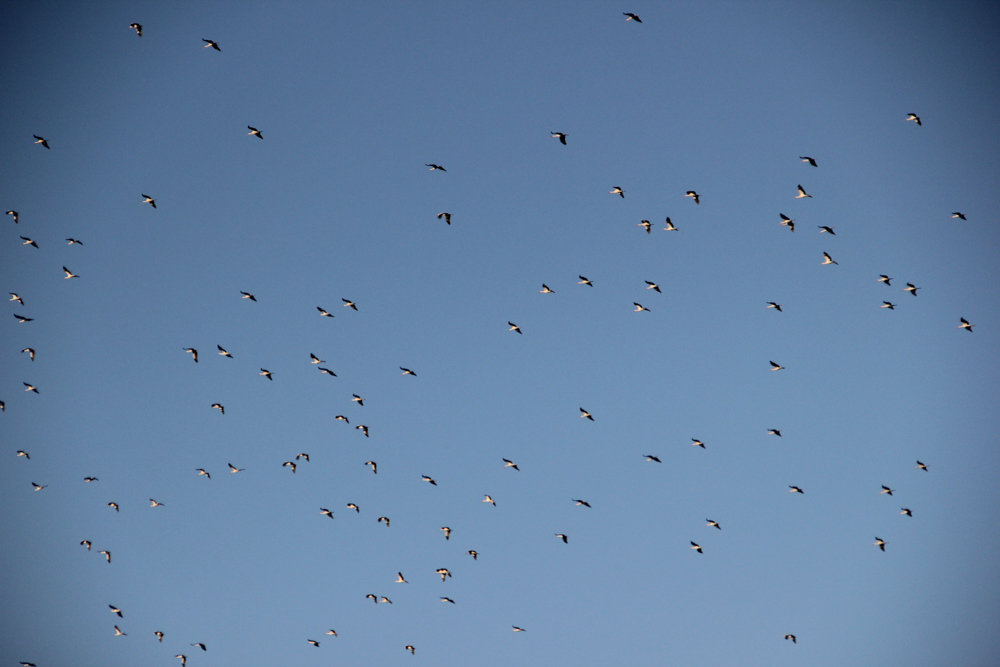Journey to stay warm: From animal migration to biology
Despite recent moderating temperatures here in Riverdale, our recent cold snap is still a searing memory. Fortunately, we humans can retreat into warm homes and heavy clothing, but how do animals cope?
Looking through my windows, I still see some bird species gathering at my birdfeeder. I see sparrows everywhere and hear the raucous calls of the blue jays from the treetops. But with the exception of squirrels, the robust presence of animals seen in summertime is missing. And while not all insects are welcome, the total absence of insect life adds to the sense of desolation that winter brings.
One well recognized method of cold avoidance in bird populations is migration, and more than 350 North American bird species migrate to the tropics each fall. Worldwide, approximately 4,000 species representing 40 percent of the total bird population migrate.
Insects may migrate as well. We are all familiar by now with the migration of the monarch butterfly. Traveling from Mexico to Canada, they fly a full 3,000 miles.
Mammals are not exempt. Humpback whales travel between 2,500 and 4,000 miles as they move between winter calving locations and summer feeding grounds traveling at a steady daily pace of one to six miles. Caribou living in North America, Europe and Siberia travel approximately 400 miles between winter and summer locations.
Migration is the answer to problems other than cold. Wildebeest, accompanied by gazelles and zebras, migrate 1,500 miles in the course of a year as they move clockwise through Kenya and Tanzania. However, they are chasing water and forage, not warmth.
Unless you are a fisherman chasing fish populations, you probably have not given much thought to fish migrations. Yet, salmon and striped bass are anadromous, meaning that the adult fish live in the sea, but return to fresh water to spawn. Catadromous fish such as eels to the reverse in that the adult fish live in fresh water and return to the ocean to reproduce.
Yet other species, such as a variety of herring, migrate from their spawning ground in southern Norway to their feeding ground in Iceland in a yearly trek.
There also is the extraordinary daily vertical migration in the ocean of zooplankton called diel (referring to periods of 24 hours) vertical migration. Derived from the Greek zoon for “animal” and planktos for “wandering,” these simple animals — characterized by their drifting on ocean currents — are divided into two groups: the meroplankton and the holoplankton.
The meroplankton are the larvae of various species such as worms, mollusks, coral and fish, and as such will change form and size as they mature. The holoplankton will retain one form for their entire lifecycle.
Vertical migration usually involves the movement of the zooplankton from the depths during nighttime hours to the upper reaches of the water where they will feed on the phytoplankton — small photosynthetic organisms — that have been producing during daylight hours.
Phyton, also from the Greek, means “plant.” As the night fades, they return to deeper waters.
The current hypothesis for this behavior is that the zooplankton are less visible predators in lower-light areas, and so stay out of sight during the day in darker, deeper waters.
But what of the animals that do not migrate? I am always amazed to see birds active in extremely cold weather seemingly untroubled by unprotected pencil-thin legs.
The only explanation I have found is called counter-current heat exchange. This means that arteries which carry warmed blood, and veins which carry cooled blood returning to the heart, are in close proximity to each other.
This promotes the transfer of heat from the arteries directly to the veins which keeps the body core warmer by limiting heat loss through the extremities.
Apparently, counter-current systems are used frequently in biological systems. The basic requirements are semi-permeable membranes which will allow exchange of some factor throughout the vessel walls.
Veins and arteries must be in close proximity with material moving in opposite directions, and a gradient of material between the two vessel types, meaning that one vessel has a greater concentration of some factor than the other.
Other animals that use counter-current exchange for heat-related issues are whales, manatees and beavers. However, such a system also is used for “breathing,” as in gills of fish where the exchange involves oxygen.
Kangaroo rats, which live in arid and semi-arid environments, use such a system to retain moisture. To prevent the exhalation of moisture, counter-current exchange allows them to inhale the dry outside air, moistening it before it reaches the lungs.
The moisture is recondensed and retained before the air is exhaled through the nose.
But what of other animals that do not migrate, nor have special adaptive pathways? Come back next time for some truly remarkable strategies!
Have a thought or comment for Sura Jeselsohn? Email her at greenscenesura@gmail.com.






